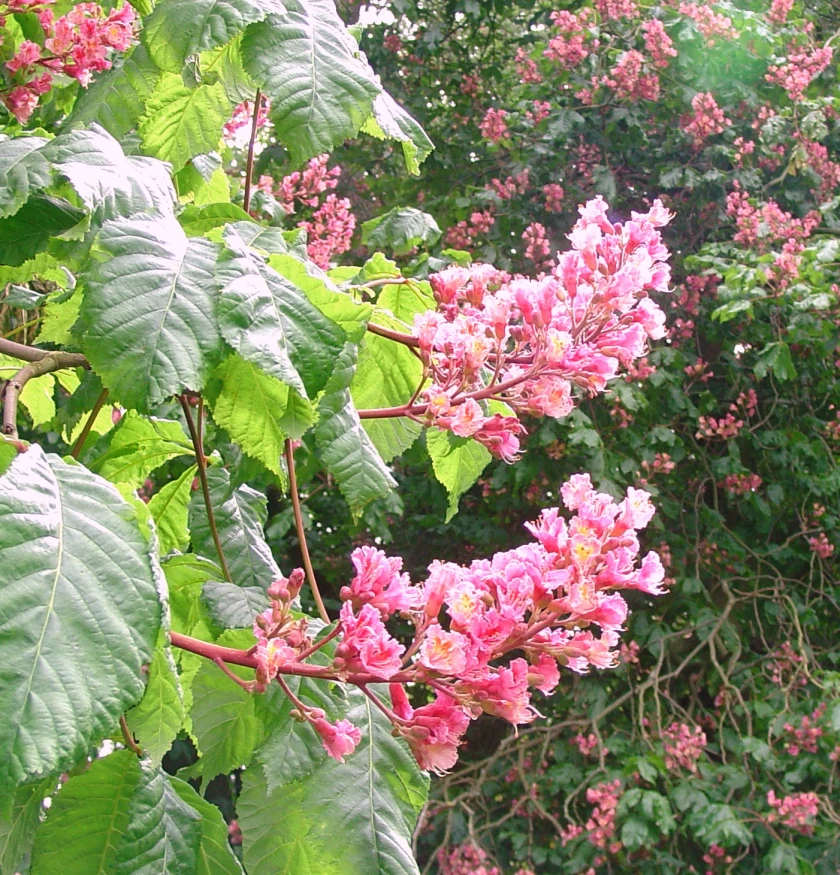Cross a Horse Chestnut with a Red Buckeye and you get…?
By: shortfinals
Tags: "..chiefly occupied by American plants, 1847, 60 to 70 ft high, A. x carnea briotii, accidental cross-pollination, Aesculus, Aesculus hippocastanum, Aesculus pavia, Aesculus x carnea, American plants, bright pink blossom, Butterley Hall, Cameraria ohridella, Canker, chestnut, Chief Horticulturalist, closely related species, country lane, cross-pollination, Cryphonectria parasitica, Derbyshire, drilling the hole through the chestnut, England, European gardeners, European species, fairly hardy plant, family home, father, Florida, France, French, from observations made during a visit in the Spring of 1847' Journal of the Royal Horticultural Society 1847 vol 2 pg 226, fruiting bodies, fungus, gardens, genus Aesculus, Great Britain, Head Gardener, Horse Chestnut, Horse Chestnut Leaf Miner Moth, Horse Chestnut Scale, Illinois, inflorescences, Journal of the Royal Horticultural Society, leaf shape, Leaf Spot, my family, Mycosphaerella maculiformis, native tree, Nectria cinnabrina, North Carolina, ornamental trees, ornamental trees and shrubs...", Peak District, Peak District National Park, pests, Pierre Louis Briot, pink, pink inflorescences, planted specimens, Police HQ, Pulvinaria regalis, recessive gene, Red Buckeye, Red Horse Chestnut, RHS, Ripley, Robert Thompson, rounded shape, Royal Rose Society, schoolboy game, schoolboy game of 'conkers', seeds, shocking pink, should not be ingested, snow-white flowers, spectacular addition to any garden, spikes, State Nurseries of the Petite-Trianon, Supervisor Orchard & Kitchen Garden, Texas, the Americas, Thompson R 'Report on the fruit and kitchen gardens near Paris, threading the string, toxic, Trianon, urban problem, USA, Versailles, very healthy, Victorian, Victorian Era, young trees
Category: British Isles, Derbyshire, England, France, Great Britain, Peak District, Plants
| Aperture: | f/3.5 |
|---|---|
| Focal Length: | 9.2mm |
| ISO: | 100 |
| Shutter: | 1/0 sec |
| Camera: | MVC-CD500 |
Strolling along a country lane in the Peak District of Derbyshire, I turned a corner and was confronted by a ‘wall’ of bright pink blossom. Many young trees were vying for growing space, and at the same time pushing out a profusion of pink inflorescences. They exhibited the typical leaf shape of the Horse Chestnut, but had shocking pink flower spikes, unlike the snow-white flowers of the native tree. When I was a small boy, growing up in Derbyshire, I had always assumed that the ‘pink’ Horse Chestnut was just a ‘sport’, something that was caused by a recessive gene. Well, as I got older, I started to listen to my family on the subject of gardens and since I had an uncle who was the last Head Gardener at Butterley Hall, Ripley (before it ceased to be a family home, and became the Police HQ) and a father who was a member of the Royal Rose Society, it was a good idea to listen! What we have here is a cross between two members of the genus Aesculus, namely, the Horse Chestnut (Aesculus hippocastanum) and the Red Buckeye (Aesculus pavia). The idea of an accidental cross-pollination from these two closely related species is quite possible, despite the fact that Horse Chestnuts are a strongly European species and the Red Buckeye is common in the area from North Carolina to Florida to East Texas and Southern Illinois in the USA. The flowers of the Red Buckeye are so striking that European gardeners of the Victorian era would, undoubtedly, have planted specimens from the Americas.
Cross pollination would have followed, giving rise to Aesculus x carnea. The resulting tree would be smaller than a chestnut, (about 60 to 70 ft high), and a more rounded shape. A number of varieties are known, but this one is probably A. x carnea briotii, named after the famous Chief Horticulturalist of the State Nurseries of the Petite-Trianon, Versailles, France, one Pierre Louis Briot. The gardens at the Trianon were, in 1847, “..chiefly occupied by American plants, ornamental trees and shrubs…” , according to Robert Thompson, the Supervisor, Orchard & Kitchen Garden, RHS (Thompson, R. ‘Report on the fruit and kitchen gardens near Paris, from observations made during a visit in the Spring of 1847’, Journal of the Royal Horticultural Society, 1847; v. 2, pg 226).
The Red Horse Chestnut is a fairly hardy plant, needing little attention; its main problems lie with two pests; Horse Chestnut Scale (Pulvinaria regalis) which is mainly an urban problem, and the Horse Chestnut Leaf Miner Moth (Cameraria ohridella). The fungus known as Coral Spot (Nectria cinnabrina) sometimes attacks, along with Canker (Cryphonectria parasitica) and Leaf Spot (Mycosphaerella maculiformis), but, in general, the tree is very healthy.
The only drawback is that the fruiting bodies, and the hard seeds – known as ‘conkers’ in the UK – are toxic, and should not be ingested; however, the Red Horse Chestnut will prove to be a spectacular addition to any garden.
Oh, and the Red Horse Chestnut would lose out in the schoolboy game of ‘conkers’ to its relative, the Horse Chestnut. I used to really look forward to drilling the hole through the chestnut, threading the string through it, and taking turns with another ‘owner’ to smash your ‘conker’ against the other one, until one of the ‘nuts’ disintegrated!
bit.ly/TPMShop
This month’s offerings!
Useful links
- Courtesy Aircraft Courtesy Aircraft are a purveyor of fine, used warbirds and other aircraft
- DONATE to the The People's Mosquito DONATE to help The People’s Mosquito Ltd build a Mosquito!
- Passiondesavions Excellent blog from a pilot and Air Traffic Controller (en francais). The photography is exceptional. C’est magnifique!
- The Mighty Jingles A truly amazing wargaming channel; aircraft (War Thunder) as well as tanks (World of Tanks)
- The People's Mosquito Ltd Help to launch a de Havilland Mosquito into British skies! An aviation charity with just one aim….
- TPM Fund Help us build a Mosqutio for Britain!
- Travelforaircraft An excellent aircraft miscellany!


Leave a comment